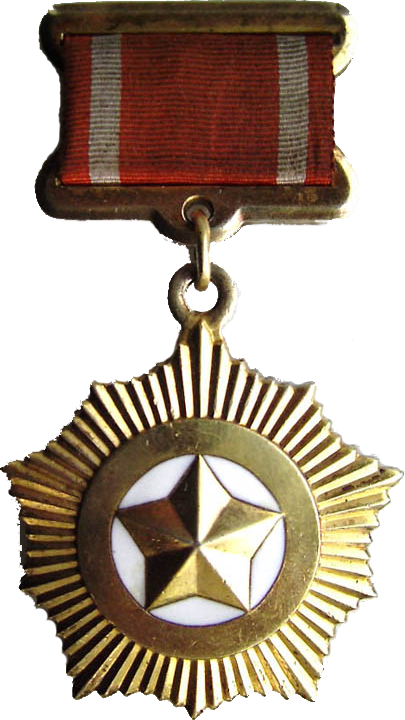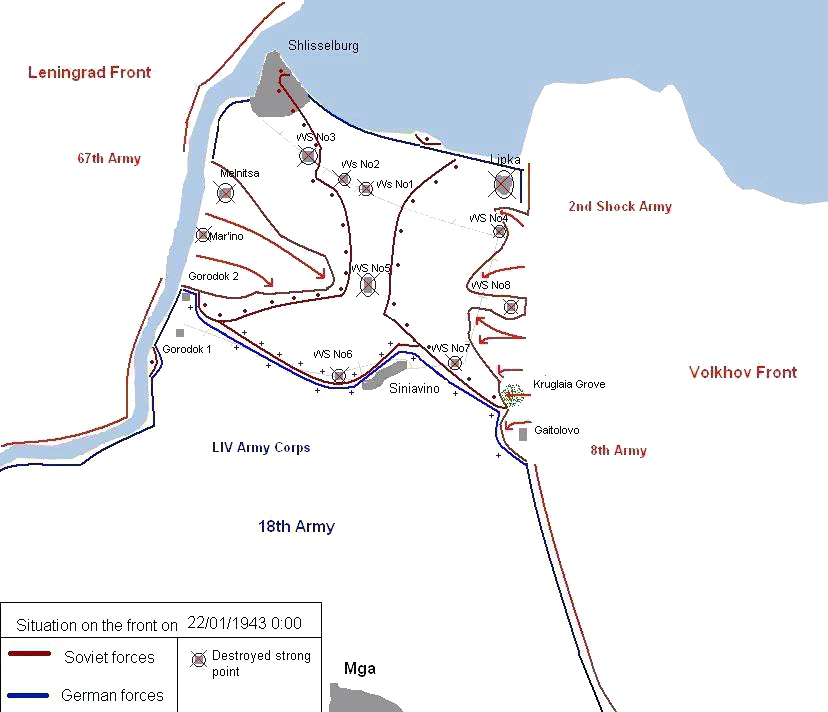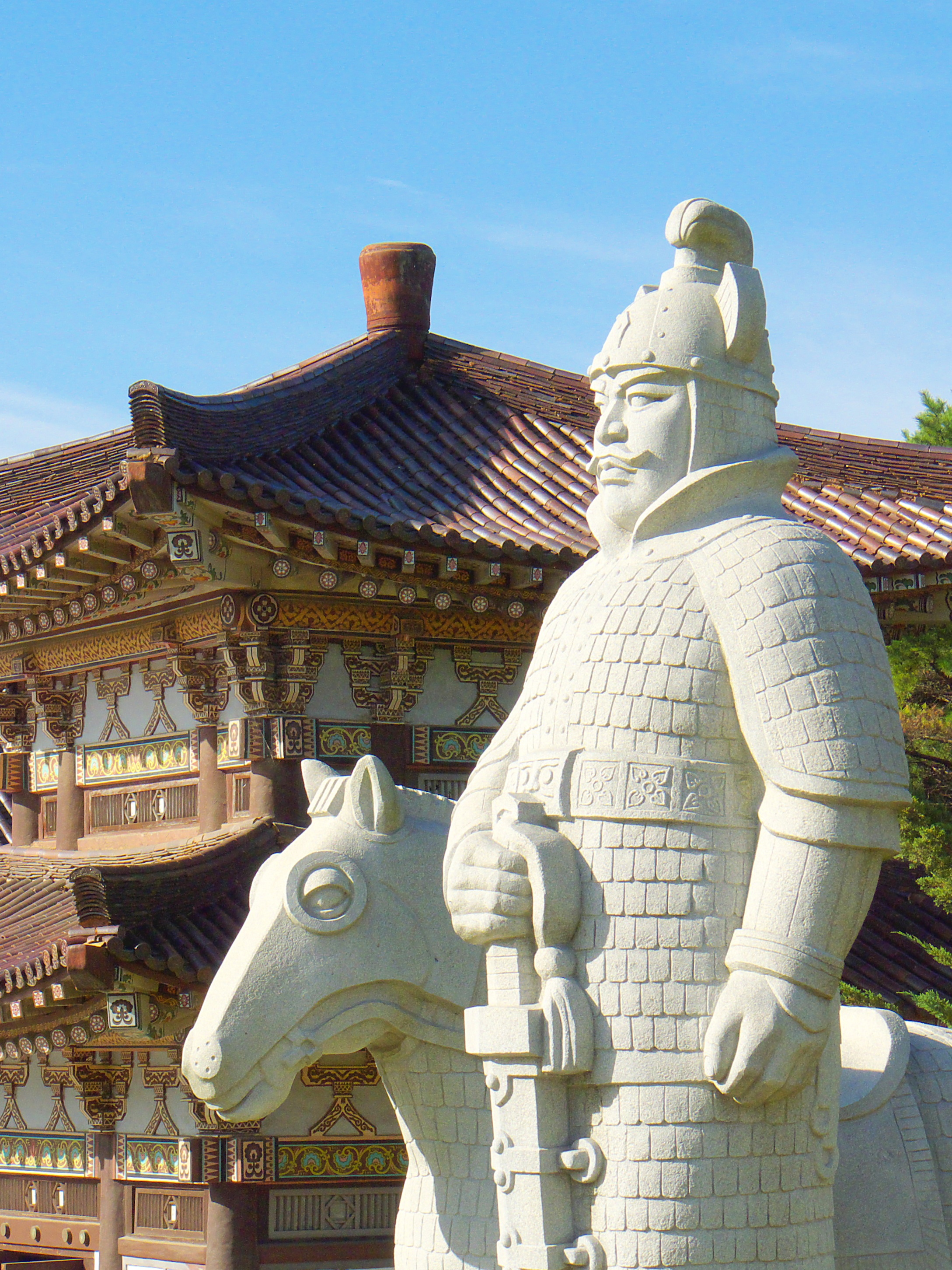|
Medal For The Liberation Of Korea
The Medal for the Liberation of Korea () (), a.k.a. Korea 15.8.1945, was a medal awarded by the Democratic People's Republic of Korea. History The medal was established on October 15, 1948, by the Decree of the Presidium of the Supreme People's Assembly. It was awarded to the Red Army servicemen who participated in the Soviet-Japanese War, which led to the liberation of the Korean Peninsula from Japanese rule. In North Korea, the medal is known as ''Chosŏn 1945.8.15'' (), which is the date of National Liberation Day of Korea. Appearance The medal is made of silver and has a diameter of 33 mm. On the obverse, in the middle, against the background of the sun's rays, is the image of the Liberation Monument in Pyongyang, which is surrounded by a wreath of laurel branches. At the intersection, there is a ribbon with the inscription 'Liberation' (). The reverse side is smooth, in the middle there is an inscription in two lines "Korea / 1945.8.15." (). The ribbon is red, with ... [...More Info...] [...Related Items...] OR: [Wikipedia] [Google] [Baidu] |
North Korea
North Korea, officially the Democratic People's Republic of Korea (DPRK), is a country in East Asia. It constitutes the northern half of the Korean Peninsula and shares borders with China and Russia to the north, at the Yalu (Amnok) and Tumen rivers, and South Korea to the south at the Korean Demilitarized Zone. North Korea's border with South Korea is a disputed border as both countries claim the entirety of the Korean Peninsula. The country's western border is formed by the Yellow Sea, while its eastern border is defined by the Sea of Japan. North Korea, like its southern counterpart, claims to be the legitimate government of the entire peninsula and adjacent islands. Pyongyang is the capital and largest city. In 1910, Korea was annexed by the Empire of Japan. In 1945, after the Japanese surrender at the end of World War II, Korea was divided into two zones along the 38th parallel, with the north occupied by the Soviet Union and the south occupied by the U ... [...More Info...] [...Related Items...] OR: [Wikipedia] [Google] [Baidu] |
Marshal Of The Soviet Union
Marshal of the Soviet Union (russian: Маршал Советского Союза, Marshal sovetskogo soyuza, ) was the highest military rank of the Soviet Union. The rank of Marshal of the Soviet Union was created in 1935 and abolished in 1991 when Dissolution of the Soviet Union, the Soviet Union dissolved. Forty-one people held this rank. The equivalent naval rank was until 1955 admiral of the fleet and from 1955 Admiral of the Fleet of the Soviet Union. While the supreme rank of Generalissimus of the Soviet Union, which would have been senior to Marshal of the Soviet Union, was proposed for Joseph Stalin after the Second World War, it was never officially approved. History of the rank The military rank of Marshal of the Soviet Union was established by a decree of the Soviet Cabinet, the Council of People's Commissars (Sovnarkom), on 22 September 1935. On 20 November, the rank was conferred on five people: People's Commissar of Defence and veteran Bolshevik Kliment Voros ... [...More Info...] [...Related Items...] OR: [Wikipedia] [Google] [Baidu] |
Orders, Decorations, And Medals Of North Korea
The award system of the Democratic People's Republic of Korea (North Korea) was initially created less than one month after the foundation of the Republic. During the years of Japanese occupation of Korea, many of the future leaders fled to the Soviet Union. During World War II many if not close to all party leaders and Korean People's Army commanders served in the Soviet Army and as such adopted many of the Soviet awards criteria for their own. During the late 1940s and until the Sino-Soviet Split in late 1958, orders and titles were made in the Soviet Money Mints in Moscow or Leningrad. Soviet made awards were modeled after Soviet orders and made of sterling silver. Initially the orders were attached to clothing with a screw-plate, but after Soviet production stopped, production was moved to North Korea. The screwback was replaced with a pin and the silver content was replaced with cheap tin. With the exception of a few examples of modern orders, Soviet and Czech KPA awards are th ... [...More Info...] [...Related Items...] OR: [Wikipedia] [Google] [Baidu] |
Flag Of North Korea
The flag of North Korea, also known as the Ramhongsaek Konghwagukgi ( ko, 람홍색공화국기; literally "blue and red-coloured flag of the republic"), sometimes known as the flag of the Democratic People's Republic of Korea, consists of a central red panel, bordered both above and below by a narrow white stripe and a broad blue stripe. The central red panel bears a five-pointed red star within a white circle near the hoist. The flag is strictly prohibited under the National Security Act in South Korea due to its association with the ruling North Korean regime, but it is only allowed in extremely exceptional cases such as media coverage, drama and film shooting, and international sports events. Design The North Korean national flag is officially defined in article 170 of Chapter VII of the North Korean constitution. According to it: Color scheme The video colors approximation is listed below: Symbolism The North Korean flag's prominent motif is a red star, which is a u ... [...More Info...] [...Related Items...] OR: [Wikipedia] [Google] [Baidu] |
Viktor Leonov
Viktor Nikolayevich Leonov (russian: Виктор Николаевич Лео́нов; – 7 October 2003) was a Soviet Navy officer and twice Hero of the Soviet Union. Considered a legend in the Soviet era after the war, he frequently gave speeches to Communist organizations about the war, but he became obscure after the fall of the Soviet Union. Early life Leonov was born on in the city of Zaraysk to a working-class family. From 1931 to 1933, he studied at the school of factory apprenticeship at the Kalibr Plant in Moscow, where he worked as a pattern fitter and combining work with social activities. He also served as the member of the plant committee of the Komsomol, chairman of the workshop committee of inventors and head of the youth brigade. In 1937 he joined the Soviet Navy and was assigned to the Northern Fleet, where he completed a training course in the S.M. Kirov Training Squadron for Diving at the city of Polyarny. He was sent for further service on the submarine ... [...More Info...] [...Related Items...] OR: [Wikipedia] [Google] [Baidu] |
Nikolai Kuznetsov (admiral)
Nikolay Gerasimovich Kuznetsov (russian: Никола́й Гера́симович Кузнецо́в; 24 July 1904 – 6 December 1974) was a Soviet Navy, Soviet naval officer who achieved the rank of Admiral of the Fleet of the Soviet Union and served as People's Commissar of the Navy during the World War II, Second World War. The N. G. Kuznetsov Naval Academy and the Russian Navy, Russian aircraft carrier , as well as the Kuznetsov-class aircraft carrier, Kuznetsov-class carrier class, are named in his honor. Biography Early years and career Kuznetsov was born into a Serbian peasant family in the village of Medvedki, Velikoustyuzhsky Uyezd, Vologda Governorate, Russian Empire (now in Kotlassky District of Arkhangelsk Oblast, Russia). In 1919, Kuznetsov joined the Northern Dvina Naval Flotilla, having added two years to his age to make himself eligible to serve. In 1920, he was stationed at Petrograd and in 1924, as a member of a naval unit, he attended the funeral ceremony ... [...More Info...] [...Related Items...] OR: [Wikipedia] [Google] [Baidu] |
Admiral Of The Fleet (Russia)
Admiral of the fleet or fleet admiral (russian: Адмирал флота, Admiral flota) is the highest naval rank of the Russian Federation. It is the equivalent of the Soviet naval rank of Fleet Admiral and the present Russian rank of army general. The rank is roughly equivalent to the rank of "admiral" of other nations. Marshal of the Russian Federation Marshal of the Russian Federation ( rus, Маршал Российской Федерации, r=Marshal Rossiyskoy Federatsii) is the highest military rank of Russia, created in 1993 following the dissolution of the Soviet Union. It ranks imm ... is the only superior rank in the Russian armed forces. List of Russian admirals of the fleet * Feliks Nikolayevich Gromov (1937-2021); promoted 13 June 1996; retired 7 November 1997; deceased 22 January 2021. * Vladimir Ivanovich Kuroyedov (b.1944); promoted 21 February 2000; retired 5 September 2005. * Vladimir Vasilyevich Masorin (b.1947); promoted 15 December 2006; ret ... [...More Info...] [...Related Items...] OR: [Wikipedia] [Google] [Baidu] |
Aleksandr Vasilevsky
Aleksandr Mikhaylovich Vasilevsky ( ru , Алекса́ндр Миха́йлович Василе́вский) (30 September 1895 – 5 December 1977) was a Soviet career- officer in the Red Army who attained the rank of Marshal of the Soviet Union in 1943. He served as the Chief of the General Staff of the Soviet Armed Forces (1942-1945) and Deputy Minister of Defense during World War II, and as Minister of Defense from 1949 to 1953. As the Chief of the General Staff from 1942 to 1945, Vasilevsky became involved in planning and coordinating almost all the decisive Soviet offensives in World War II, from the Operation Uranus of November 1942 to the assaults on East Prussia (January–April 1945), Königsberg (January–April 1945) and Manchuria (August 1945). Vasilevsky began his military career during World War I, earning the rank of captain by 1917. After the October Revolution of 1917 and the start of the Civil War of 1917–1922 he was conscripted into the Red Army, ... [...More Info...] [...Related Items...] OR: [Wikipedia] [Google] [Baidu] |
Kirill Meretskov
Kirill Afanasievich Meretskov (russian: Кири́лл Афана́сьевич Мерецко́в; – 30 December 1968) was a Soviet military commander. Having joined the Communist Party in 1917, he served in the Red Army from 1920. During the Winter War of 1939–1940 against Finland, he had the task of penetrating the Mannerheim Line as commander of the 7th Army. He was awarded the title of Hero of the Soviet Union shortly afterwards. The NKVD arrested Meretskov at the start of invasion of the Soviet Union. Released two months later, he returned to command the 7th Army and later the Volkhov Front during the 1941–1944 siege of Leningrad. He commanded the Karelian Front from February 1944, notably the Petsamo–Kirkenes Offensive of October 1944. From April 1945 he was assigned to the Far East, where he commanded a front during the Soviet invasion of Japanese Manchuria. During the war he reached the rank of Marshal of the Soviet Union. [...More Info...] [...Related Items...] OR: [Wikipedia] [Google] [Baidu] |
Rodion Malinovsky
Rodion Yakovlevich Malinovsky (russian: Родио́н Я́ковлевич Малино́вский, ukr, Родіо́н Я́кович Малино́вський ; – 31 March 1967) was a Soviet military commander. He was Marshal of the Soviet Union, and Minister of Defence of the Soviet Union in the late 1950s and 1960s. During World War II, he contributed to the defeat of Nazi Germany at the Battle of Stalingrad and the Battle of Budapest. During the post-war era, he made a pivotal contribution to the strengthening of the Soviet Union as a military superpower. Early life Before and during World War I A Ukrainian, Malinovsky was born in Odessa to a single mother (a version has Malinovsky being born after the death of his father, others simply have the father as unknown). Malinovsky's mother soon left the city for the rural areas of Southern Russia, and married. Her husband, a poverty-stricken peasant, refused to adopt her son and expelled him when Malinovsky was only 1 ... [...More Info...] [...Related Items...] OR: [Wikipedia] [Google] [Baidu] |
Pyongyang
Pyongyang (, , ) is the capital and largest city of North Korea, where it is known as the "Capital of the Revolution". Pyongyang is located on the Taedong River about upstream from its mouth on the Yellow Sea. According to the 2008 population census, it has a population of 3,255,288. Pyongyang is a directly administered city () with equal status to North Korean provinces. Pyongyang is one of the oldest cities in Korea. It was the capital of two ancient Korean kingdoms, Gojoseon and Goguryeo, and served as the secondary capital of Goryeo. Much of the city was destroyed during the First Sino-Japanese War, but it was revived under Japanese rule and became an industrial center. Following the establishment of North Korea in 1948, Pyongyang became its ''de facto'' capital. The city was again devastated during the Korean War, but was quickly rebuilt after the war with Soviet assistance. Pyongyang is the political, industrial and transport center of North Korea. It is home to ... [...More Info...] [...Related Items...] OR: [Wikipedia] [Google] [Baidu] |








